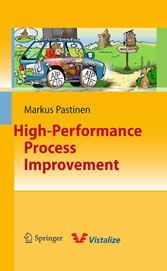Search and Find
Service
Preface
6
Acknowledgment
12
Contents
13
List of Figures
16
Chapter 1: High-Performance Process Improvement Fundamentals
25
Why is Process Improvement an Enormous Waste of Resources and Opportunities?
26
Why are the Process Improvement Methods Outdated?
30
The Critical Questions the Business Books Missed to Ask and Answer: Until Now
32
The Current and Prospective State of Process Improvement Methods
33
The Research and Development Work and its Result
34
The Size of the Improvement Momentum Toyota Loses Every Day and the Momentum Your Company Could Gain Every Day
36
Designing High-Performance Process Improvement Methods
42
Defining the Performance Requirements of High-Performance Process Improvement Efforts
43
Summary and Concluding Remarks
45
Chapter 2: High-Performance Process Improvement Concepts
48
Key Definitions
48
Delivery of Value
50
Delivery of Value from a Holistic Perspective
50
Delivery of Value from a Key Stakeholder Perspective
54
Customer Satisfaction
55
Employee Satisfaction
58
Owner Satisfaction
60
The Kernel of High-Performance Process Improvement
63
The Process and Total Improvement Yield
66
The Process Improvement Yield Concept
67
The Total Improvement Yield Concept
69
Summary and Concluding Remarks
70
Chapter 3: Design Concepts of the High-Performance Process Improvement Process
72
Standardization and Manageability
73
Optimizing the Interaction of the Process Components
74
People
75
Technology
78
Information
79
Applying the Concept of Reverse Engineering
79
The Total Picture
84
Assuring the Quality of the Experts in Charge of the High-Performance Process Improvement Process
86
Summary and Concluding Remarks
87
Chapter 4: Network and Company Analysis and Synthesis
89
Introduction
89
The Process Flow
91
The Data Collection and Analysis Criteria
93
The Functional Perspective
93
The Operational Perspective
94
The Time Space Perspective
95
Data Collection Criteria Case
95
Data Collection Concerns
100
The Synthesis
104
The T and V Values
108
Summary and Concluding Remarks
110
Chapter 5: Process Analysis and Synthesis
112
Introduction
113
Overview
116
The VISTALIZER for Consultants Concept
118
The VISTALIZER for Process Analysis and Synthesis Framework
118
Phase 1: Initiation and Modeling
123
Initiation of the Analysis (Phase 1.1)
124
Modeling of the Focus Process (Phase 1.2)
124
Scope Definition and Data Collection Planning (Phase 1.3)
129
Phase 2: Data Collection and Basic Definitions
130
Determination of the Process Performance Parameters (Phase 2.1)
131
Time Analysis Parameters
134
Quality Analysis Parameters
135
Cost Analysis Parameters
138
Examples of Chosen Analysis Parameters
139
Creation of the Impact Field (Phase 2.2)
139
The Supplements of the Impact Field
143
Examples of Impact Fields
144
Giving Priority to the Analysis Parameters (Phase 2.3)
146
Calculation of Criterion 1 and the Reliability Index of the Impact Field (Phase 2.4)
149
Planning for the External Analysis (Phase 2.5)
151
Setting the Objectives and Evaluation of the Preliminary Monetary Gains (Phase 2.6)
154
Phase 3: Sub-process Specific Improvement Plans
159
Analysis of the Specific Sub-processes (Phase 3.1)
159
Defining the Sub-process Components (Phase 3.1.1)
160
Identifying Improvement Objects (Phase 3.1.2)
161
Placing the Improvement Objects in Order of Importance (Phase 3.1.3)
163
Rough Analysis of Likely Causes and Potential Solutions (Phase 3.1.4)
163
Complementing the Sub-process Specific Analysis (Phase 3.2)
165
The Optional External Analysis (Phase 3.3)
168
Phase 4: The Synthesis and Creation of the VISTALIZER Report
170
Processing the Analysis Information and Calibrating Management Expectations (Phase 4.1)
171
Comparing the Objectives to the Realistic Improvement Potentials
172
Verifying the Analysis Phase and Defining the Improvement Momentum
175
Calculating Financial Outcomes and Detecting Improvement Initiatives with a Low Financial Outcome
178
Calibrating Management Expectations (Phase 4.1.4)
183
Presynthesis (Phase 4.2)
184
Creation of the VISTALIZER Report (Phase 4.3)
184
Delivery, Presentation and Confirmation of the VISTALIZER Report (Phase 4.4)
187
The T and V Values
187
Summary and Concluding Remarks
189
Chapter 6: The Implementation
191
Increasing and Maintaining the Knowledge and Skill Base
193
Increasing and Maintaining the Knowledge Base
194
The Car Analogy
196
The Mountain Analogy
199
Increasing and Maintaining the Skill Base
202
Basics and Philosophy
203
The PDCA Training Module
206
The Main Tools Used Within the PDCA Framework
210
The Realization
212
The Follow-Up
212
The T and V Values
215
Summary and Concluding Remarks
216
Chapter 7: Derivative Concepts and Future Outlines
218
Strategy and Strategy Process Improvement
219
The Strategy Improvement Concept
220
Strategy Process Analysis and Synthesis
221
Acid Tests
224
Future Outlines of High-Performance Process Improvement
225
Summary and Concluding Remarks
228
References
229
Index
231
All prices incl. VAT












